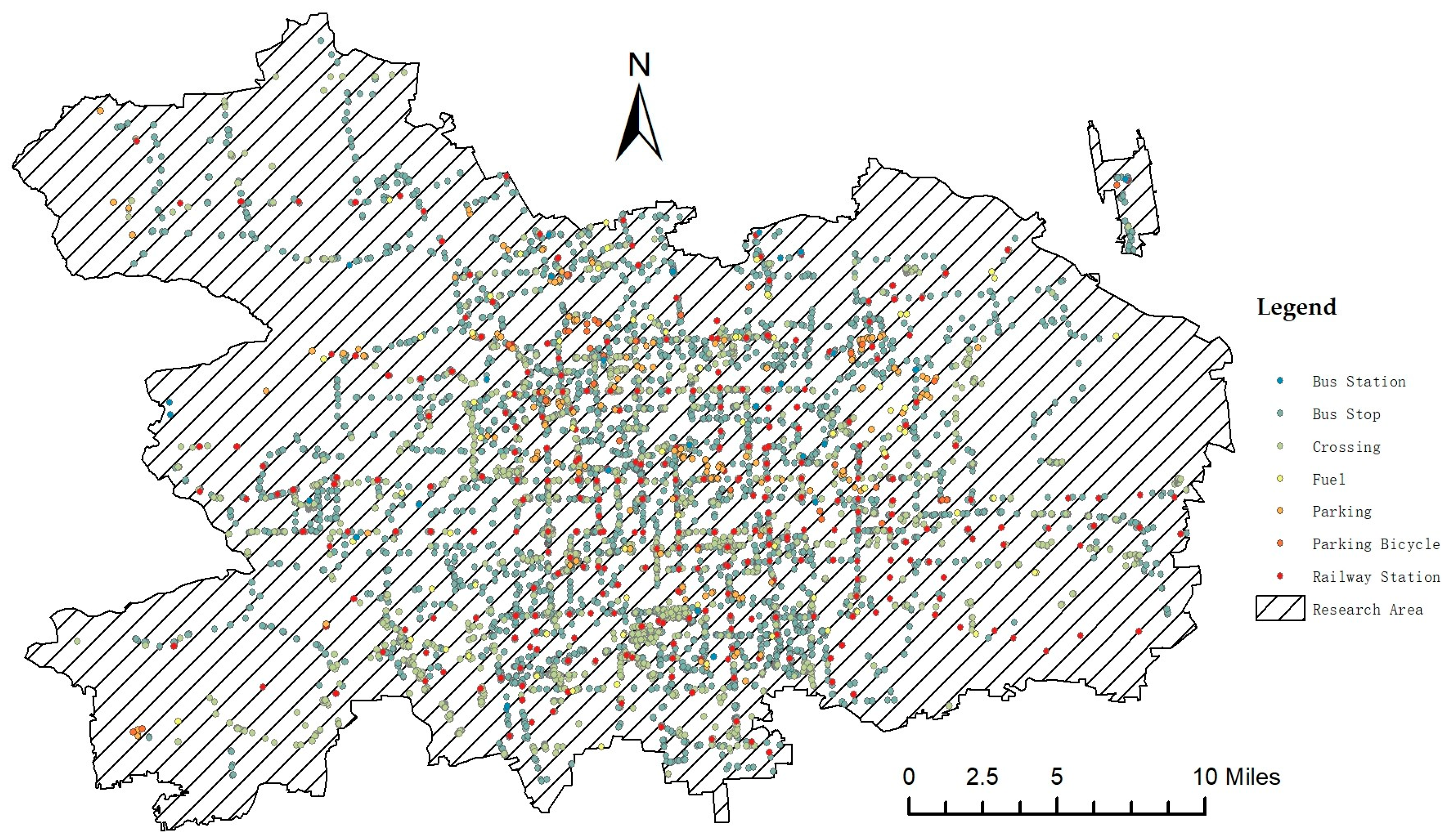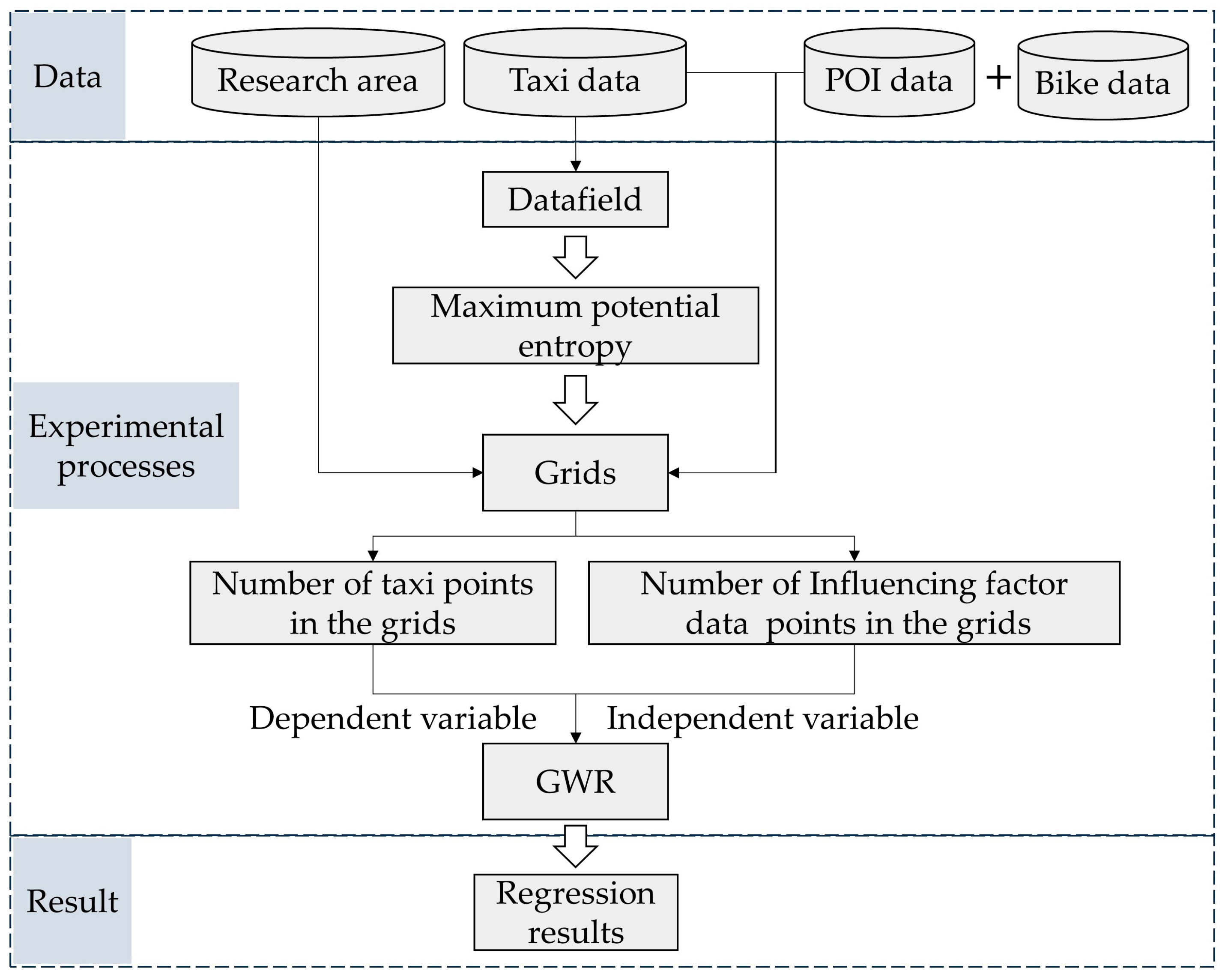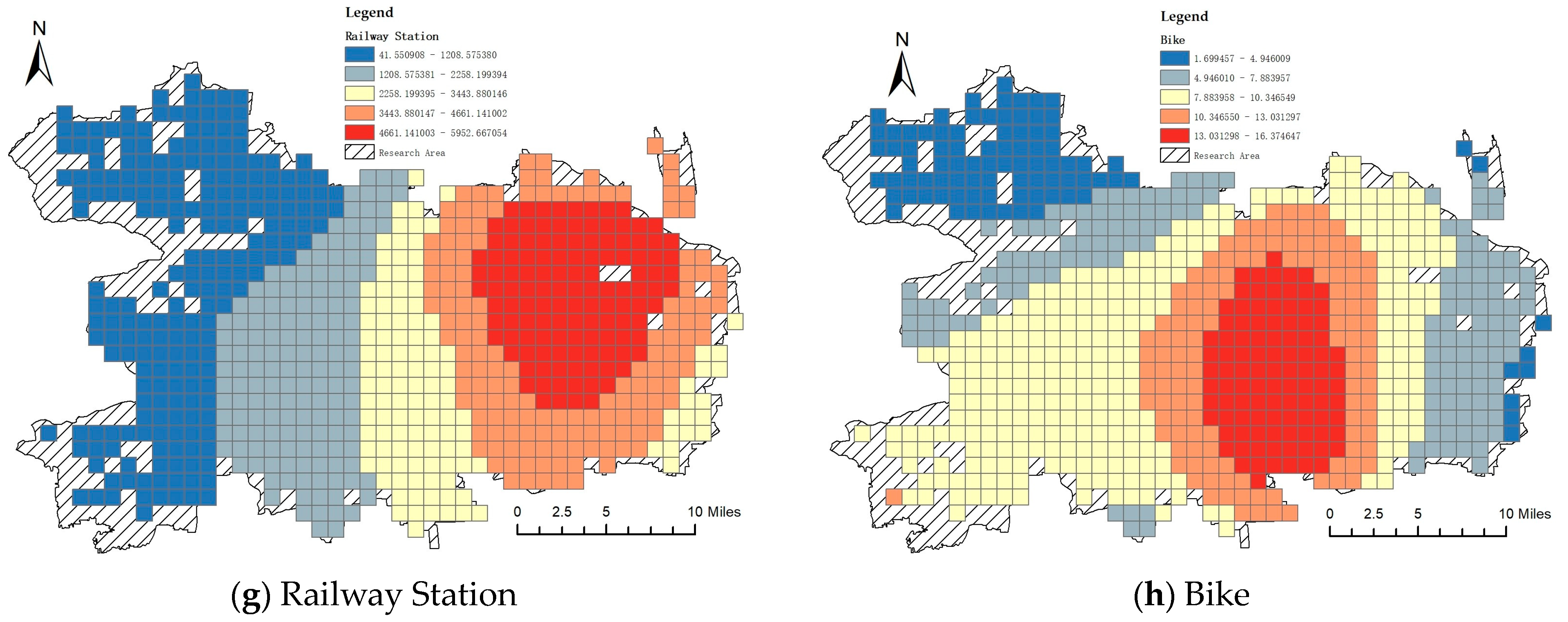Analysis of Taxi Demand and Traffic Influencing Factors in Urban Core Area Based on Data Field Theory and GWR Model: A Case Study of Beijing
Abstract
:1. Introduction
2. Study Area and Data
2.1. Study Area
2.2. Data Sources
3. Methodology
3.1. Data Field Theory
3.2. Geographically Weighted Regression Methods
3.3. Technical Approach
4. Results
4.1. Analysis of Potential Entropy Calculation Results
4.2. Geographically Weighted Regression Analysis
5. Discussion
6. Conclusions
Author Contributions
Funding
Institutional Review Board Statement
Informed Consent Statement
Data Availability Statement
Acknowledgments
Conflicts of Interest
References
- Vansteenwegen, P.; Souffriau, W.; Berghe, G.V.; Oudheusden, D.V. The City Trip Planner: An Expert System for Tourists. Expert Syst. Appl. 2011, 38, 6540–6546. [Google Scholar] [CrossRef]
- Dolnicar, S.; Laesser, C.; Matus, K. Short-Haul City Travel Is Truly Environmentally Sustainable. Tour. Manag. 2010, 31, 505–512. [Google Scholar] [CrossRef]
- Le-Klähn, D.T.; Hall, C.M. Tourist use of public transport at destinations–a review. Curr. Issues Tour. 2015, 18, 785–803. [Google Scholar] [CrossRef]
- Hall, C.M.; Le-Klähn, D.T.; Ram, Y. Tourism, Public Transport and Sustainable Mobility; Channel View Publications; Taylor & Francis: Abingdon, UK, 2017; Volume 4. [Google Scholar]
- Cai, H.; Jia, X.; Chiu, A.S.F.; Hu, X.; Xu, M. Siting Public Electric Vehicle Charging Stations in Beijing Using Big-Data Informed Travel Patterns of the Taxi Fleet. Transp. Res. Part D Transp. Environ. 2014, 33, 39–46. [Google Scholar] [CrossRef]
- Kamga, C.; Yazici, M.A.; Singhal, A. Analysis of Taxi Demand and Supply in New York City: Implications of Recent Taxi Regulations. Transp. Plan. Technol. 2015, 38, 601–625. [Google Scholar] [CrossRef]
- Yang, W.H.; Wong, R.C.P.; Szeto, W.Y. Modeling the Acceptance of Taxi Owners and Drivers to Operate Premium Electric Taxis: Policy Insights into Improving Taxi Service Quality and Reducing Air Pollution. Transp. Res. Part A Policy Pract. 2018, 118, 581–593. [Google Scholar] [CrossRef]
- Chen, T.-Y.; Chang, H.-L.; Tzeng, G.-H. Using Fuzzy Measures and Habitual Domains to Analyze the Public Attitude and Apply to the Gas Taxi Policy. Eur. J. Oper. Res. 2002, 137, 145–161. [Google Scholar] [CrossRef]
- Mukai, N.; Yoden, N. Taxi Demand Forecasting Based on Taxi Probe Data by Neural Network. In Intelligent Interactive Multimedia: Systems and Services; Watanabe, T., Watada, J., Takahashi, N., Howlett, R.J., Jain, L.C., Eds.; Springer: Berlin/Heidelberg, Germany, 2012; pp. 589–597. [Google Scholar]
- Yang, C.; Gonzales, E.J. Modeling Taxi Trip Demand by Time of Day in New York City. Transp. Res. Rec. J. Transp. Res. Board 2014, 2429, 110–120. [Google Scholar] [CrossRef]
- Wong, R.C.P.; Szeto, W.Y.; Wong, S.C. Bi-Level Decisions of Vacant Taxi Drivers Traveling towards Taxi Stands in Customer-Search: Modeling Methodology and Policy Implications. Transp. Policy 2014, 33, 73–81. [Google Scholar] [CrossRef]
- Szeto, W.Y.; Wong, R.C.P.; Yang, W.H. Guiding Vacant Taxi Drivers to Demand Locations by Taxi-Calling Signals: A Sequential Binary Logistic Regression Modeling Approach and Policy Implications. Transp. Policy 2019, 76, 100–110. [Google Scholar] [CrossRef]
- Jianqin, Z.; Peiyuan, Q.; Yingchao, D.; Mingyi, D.; Feng, L. A Space-Time Visualization Analysis Method for Taxi Operation in Beijing. J. Vis. Lang. Comput. 2015, 31, 1–8. [Google Scholar] [CrossRef]
- Horsu, E.N.; Yeboah, S.T. Influence of Service Quality on Customer Satisfaction: A Study of Minicab Taxi Services in Cape Coast, Ghana. Int. J. Econ. Commer. Manag. 2015, 3, 1451–1464. [Google Scholar]
- Nguyen-Phuoc, D.Q.; Su, D.N.; Tran, P.T.K.; Le, D.-T.T.; Johnson, L.W. Factors Influencing Customer’s Loyalty towards Ride-Hailing Taxi Services—A Case Study of Vietnam. Transp. Res. Part A Policy Pract. 2020, 134, 96–112. [Google Scholar] [CrossRef]
- Xu, T.; Zhu, H.; Zhao, X.; Liu, Q.; Xiong, H. Taxi Driving Behavior Analysis in Latent Vehicle-to-Vehicle Networks: A Social Influence Perspective. In Proceedings of the 22nd ACM SIGKDD International Conference, San Francisco, CA, USA, 13–17 August 2016. [Google Scholar]
- Huang, Y.-W.; Lin, P.-C.; Wang, J. The Influence of Bus and Taxi Drivers’ Public Self-Consciousness and Social Anxiety on Aberrant Driving Behaviors. Accid. Anal. Prev. 2018, 117, 145–153. [Google Scholar] [CrossRef]
- Kamga, C.; Yazici, M.A.; Singhal, A. Hailing in the Rain: Temporal and Weather-Related Variations in Taxi Ridership and Taxi Demand-Supply Equilibrium. In Proceedings of the Transportation Research Board Annual Meeting, Washington DC, USA, 13–17 January 2013. [Google Scholar]
- Liu, Y.; Yan, X.; Wang, Y.; Yang, Z.; Wu, J. Grid Mapping for Spatial Pattern Analyses of Recurrent Urban Traffic Congestion Based on Taxi GPS Sensing Data. Sustainability 2017, 9, 533. [Google Scholar] [CrossRef]
- Kong, X.; Yang, J.; Yang, Z. Measuring Traffic Congestion with Taxi GPS Data and Travel Time Index. In Proceedings of the Cota International Conference of Transportation Professionals, Beijing, China, 24–27 July 2015. [Google Scholar]
- Lyu, Y.; Chow, C.-Y.; Lee, V.C.S.; Li, Y.; Zeng, J. T2CBS: Mining Taxi Trajectories for Customized Bus Systems. In Proceedings of the 2016 IEEE Conference on Computer Communications Workshops (INFOCOM WKSHPS), San Francisco, CA, USA, 10–14 April 2016; pp. 441–446. [Google Scholar]
- Tang, L.; Sun, F.; Kan, Z.; Ren, C.; Cheng, L. Uncovering Distribution Patterns of High Performance Taxis from Big Trace Data. ISPRS Int. J. Geo-Inf. 2017, 6, 134. [Google Scholar] [CrossRef]
- Wang, H.; Huang, H.; Ni, X.; Zeng, W. Revealing Spatial-Temporal Characteristics and Patterns of Urban Travel: A Large-Scale Analysis and Visualization Study with Taxi GPS Data. ISPRS Int. J. Geo-Inf. 2019, 8, 257. [Google Scholar] [CrossRef]
- Wang, Y.; Qin, K.; Chen, Y.; Zhao, P. Detecting Anomalous Trajectories and Behavior Patterns Using Hierarchical Clustering from Taxi GPS Data. IJGI 2018, 7, 25. [Google Scholar] [CrossRef]
- Wong, R.C.P.; Szeto, W.Y.; Wong, S.C. A Two-Stage Approach to Modeling Vacant Taxi Movements. Transp. Res. Procedia 2015, 7, 254–275. [Google Scholar] [CrossRef]
- Albalate, D.; Bel, G. Tourism and urban public transport: Holding demand pressure under supply constraints. Tour. Manag. 2010, 31, 425–433. [Google Scholar] [CrossRef]
- La, Q.N.; Lee, A.H.; Meuleners, L.B.; Van Duong, D. Prevalence and Factors Associated with Road Traffic Crash among Taxi Drivers in Hanoi, Vietnam. Accid. Anal. Prev. 2013, 50, 451–455. [Google Scholar] [CrossRef] [PubMed]
- Chen, D.; Wang, J.; Xiong, C. Research on Origin-Destination Travel Demand Prediction Method of Inter-Regional Online Taxi Based on SpatialOD-BiConvLSTM. IET Intell. Transp. Syst. 2021, 15, 1533–1547. [Google Scholar] [CrossRef]
- Qu, H.; Zhao, Z. The Application of Lagrange Relaxation on Taxi Dispatchments During Evening Rush Hours. J. Phys. Conf. Ser. 2020, 1650, 032019. [Google Scholar] [CrossRef]
- Qian, X.; Ukkusuri, S.V. Spatial Variation of the Urban Taxi Ridership Using GPS Data. Appl. Geogr. 2015, 59, 31–42. [Google Scholar] [CrossRef]
- Cui, H.; Wu, L.; Hu, S.; Lu, R.; Wang, S. Recognition of Urban Functions and Mixed Use Based on Residents’ Movement and Topic Generation Model: The Case of Wuhan, China. Remote Sens. 2020, 12, 2889. [Google Scholar] [CrossRef]
- Lyu, T.; Wang, P.S.; Gao, Y.; Wang, Y. Research on the Big Data of Traditional Taxi and Online Car-Hailing: A Systematic Review. J. Traffic Transp. Eng. 2021, 8, 1–34. [Google Scholar] [CrossRef]
- Faghih-Imani, A.; Anowar, S.; Miller, E.J.; Eluru, N. Hail a cab or ride a bike? A travel time comparison of taxi and bicycle-sharing systems in New York City. Transp. Res. Part A Policy Pract. 2017, 101, 11–21. [Google Scholar] [CrossRef]
- Dai, H.; Tao, Y.; Lin, H. Visual analytics of urban transportation from a bike-sharing and taxi perspective. In Proceedings of the 12th International Symposium on Visual Information Communication and Interaction, Shanghai, China, 20–22 September 2019; pp. 1–8. [Google Scholar]
- Ni, Y.; Chen, J. Exploring the effects of the built environment on two transfer modes for metros: Dockless bike sharing and taxis. Sustainability 2020, 12, 2034. [Google Scholar] [CrossRef]
- Jiang, W. Bike sharing usage prediction with deep learning: A survey. Neural Comput. Appl. 2022, 34, 15369–15385. [Google Scholar] [CrossRef]
- Kou, Z.; Cai, H. Understanding bike sharing travel patterns: An analysis of trip data from eight cities. Phys. A Stat. Mech. Its Appl. 2019, 515, 785–797. [Google Scholar] [CrossRef]
- Wu, J.; He, Q.; Chen, Y.; Lin, J.; Wang, S. Dismantling the Fence for Social Justice? Evidence Based on the Inequity of Urban Green Space Accessibility in the Central Urban Area of Beijing. Environ. Plan. B Urban Anal. City Sci. 2020, 47, 626–644. [Google Scholar] [CrossRef]
- Thomas, A. Development and Properties of 0.25-Degree Gridded Evapotranspiration Data Fields of China for Hydrological Studies. J. Hydrol. 2008, 358, 145–158. [Google Scholar] [CrossRef]
- Chen, Y.; Yue, W.; La Rosa, D. Which Communities Have Better Accessibility to Green Space? An Investigation into Environmental Inequality Using Big Data. Landsc. Urban Plan. 2020, 204, 103919. [Google Scholar] [CrossRef]
- He, N.; Gan, W.Y.; Li, D.Y. Evaluate nodes importance in the network using data field theory. In Proceedings of the 2007 International Conference on Convergence Information Technology (ICCIT 2007), Gyeongju, Republic of Korea, 21–23 November 2007; IEEE: Piscataway, NJ, USA, 2007; pp. 1225–1234. [Google Scholar]
- Zhou, C.; Huang, H.; Liu, Z.; Ding, Y.; Xiao, J.; Shu, Y. Identification and analysis of ship carbon emission hotspots based on data field theory: A case study in Wuhan Port. Ocean Coast. Manag. 2023, 15, 106479. [Google Scholar] [CrossRef]
- Qin, K.; Zhou, Q.; Wu, T.; Xu, Y.Q. Hotspots detection from trajectory data based on spatiotemporal data field clustering. The International Archives of the Photogrammetry. Remote. Sens. Spat. Inf. Sci. 2017, 14, 1319–1325. [Google Scholar]
- Athanesious, J.J.; Chakkaravarthy, S.S.; Vasuhi, S.; Vaidehi, V. Trajectory based abnormal event detection in video traffic surveillance using general potential data field with spectral clustering. Multimed. Tools Appl. 2019, 78, 19877–19903. [Google Scholar] [CrossRef]
- Wang, H.; Deng, Y.; Wang, L.; Guan, X. A c-means algorithm based on data field. Geomat. Inf. Sci. Wuhan Univ. 2009, 34, 626–629. [Google Scholar]
- Lu, B.; Yang, W.; Ge, Y.; Harris, P. Improvements to the Calibration of a Geographically Weighted Regression with Parameter-Specific Distance Metrics and Bandwidths. Comput. Environ. Urban Syst. 2018, 71, 41–57. [Google Scholar] [CrossRef]
- Tang, J.; Gao, F.; Liu, F.; Zhang, W.; Qi, Y. Understanding Spatio-Temporal Characteristics of Urban Travel Demand Based on the Combination of GWR and GLM. Sustainability 2019, 11, 5525. [Google Scholar] [CrossRef]
- Tang, J.; Gao, F.; Han, C.; Cen, X.; Li, Z. Uncovering the Spatially Heterogeneous Effects of Shared Mobility on Public Transit and Taxi. J. Transp. Geogr. 2021, 95, 103134. [Google Scholar] [CrossRef]
- Basak, E.; Iris, Ç. Shifting Gears: Examining the Complementary and Substitution Effects of Bikesharing Platforms on Public Transit. Available online: https://ssrn.com/abstract=4391093 (accessed on 16 January 2023).













| Data Name | Data Field Name | Data Field Content | Data Size |
|---|---|---|---|
| Taxi OD data | TIME | Collection time | 3,600,000 entries |
| TAXI_ID | Taxi license plate number | ||
| O_LATITUDE | Latitude of origin/° | ||
| O_LONGITUDE | Longitude of origin/° | ||
| D_LATITUDE | Latitude of destination/° | ||
| D_LONGITUDE | Longitude of destination/° |
| Data Name | Data Size | Data Field Content | Data Field Name |
|---|---|---|---|
| Bike-sharing location data | 376, 893 entries | Collection time | TIME |
| Bike-sharing ID number | BIKE_ID | ||
| Latitude/° | LATITUDE | ||
| Longitude/° | LONGITUDE |
| Data Name | Data Size/Entries | Data Description |
|---|---|---|
| Bus Station | 30 | Long-distance bus station |
| Bus Stop | 4030 | Roadside bus stop |
| Crossing | 3075 | Intersection in the middle of the road |
| Fuel | 70 | Gas station |
| Parking | 175 | Car parking lot (both open-air and underground) |
| Parking Bicycle | 32 | Bike-sharing parking hub |
| Railway Station | 319 | Urban subway stations |
Disclaimer/Publisher’s Note: The statements, opinions and data contained in all publications are solely those of the individual author(s) and contributor(s) and not of MDPI and/or the editor(s). MDPI and/or the editor(s) disclaim responsibility for any injury to people or property resulting from any ideas, methods, instructions or products referred to in the content. |
© 2024 by the authors. Licensee MDPI, Basel, Switzerland. This article is an open access article distributed under the terms and conditions of the Creative Commons Attribution (CC BY) license (https://creativecommons.org/licenses/by/4.0/).
Share and Cite
Zhang, M.; Tian, D.; Liu, J.; Li, X. Analysis of Taxi Demand and Traffic Influencing Factors in Urban Core Area Based on Data Field Theory and GWR Model: A Case Study of Beijing. Sustainability 2024, 16, 7386. https://doi.org/10.3390/su16177386
Zhang M, Tian D, Liu J, Li X. Analysis of Taxi Demand and Traffic Influencing Factors in Urban Core Area Based on Data Field Theory and GWR Model: A Case Study of Beijing. Sustainability. 2024; 16(17):7386. https://doi.org/10.3390/su16177386
Chicago/Turabian StyleZhang, Man, Dongwei Tian, Jingming Liu, and Xuehua Li. 2024. "Analysis of Taxi Demand and Traffic Influencing Factors in Urban Core Area Based on Data Field Theory and GWR Model: A Case Study of Beijing" Sustainability 16, no. 17: 7386. https://doi.org/10.3390/su16177386





